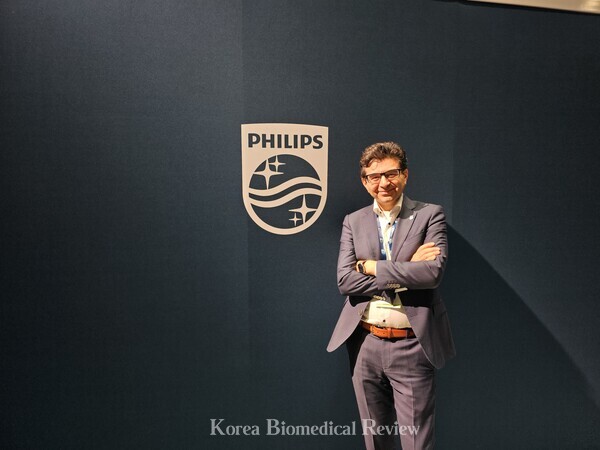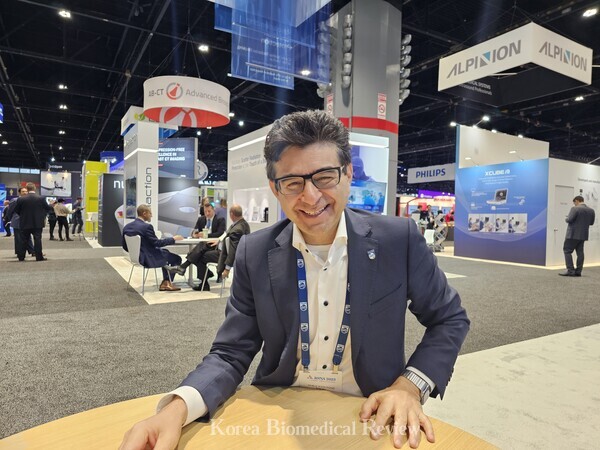CHICAGO, Ill. -- By Lee Han-soo/Korea Biomedical correspondent – With the increase in diagnostic data and ongoing workforce shortages contributing to high levels of burnout among radiologists, Philips is focusing on innovating solutions that aim to streamline radiological processes.

Led by Chief Innovation and Strategy Officer Shez Partovi, the company is developing advanced workflow optimization and informatics technologies.
These efforts include the integration of AI in clinical workflows and providing support for radiology technicians.
Philips' initiatives are geared towards reducing radiologists' workload, enhancing diagnoses' accuracy, and improving overall patient care outcomes.
Korea Biomedical Review met with Partovi during RSNA 2023 to discuss in detail how Philips is aiming to address problems in the field of radiology and what he views the future will be in the field.
Partovi, drawing from his experience as a neuroradiologist, emphasized the importance of understanding the end user's needs, including physicians, nurses, and patients.
"Living in the shoes of physicians gives you a very unique perspective as to their pain points and their needs," Partovi said. "As a result, addressing the current problems in radiology is very personal to me."
Partovi also reflected on his journey as a neuroradiologist, from handling 20 images in a CT brain examination back in 1996 to grappling with 1,200 images for the same procedure years later – a clear illustration of the data overload crisis in modern radiology.
"This massive influx of data, while enabling more precise diagnoses, has also created a significant imbalance, and the advancements in imaging technology have far outpaced the evolution of radiology workflows," he said. "This is at the heart of the burnout crisis in radiology."
Partovi outlines how optimizing workflows, rather than focusing merely on technical specifications, can lead to faster, more accurate diagnoses, thus alleviating some of the burdens on healthcare professionals.
Notably, the Covid-19 pandemic has really highlighted such shortcomings and has accelerated Philips' works in addressing these issues by using technologies, such as a hybrid system that allows radiologists to also work from home and the office.
"After the pandemic, the entire field of radiology changed, and radiologists all went home to read films during the pandemic, and quite frankly, 70 percent of them have never come back," he explained.
This shift to a hybrid way of working has become the new norm, necessitating systems like Philips' picture archiving and communication system (PACs), which deliver seamless and efficient remote working capabilities.
"Our goal is clear: reduce the time to diagnosis without compromising quality," he said.
Despite such drastic changes, Partovi stressed that patient-centricity still remains a focal point in Philips' innovation strategy,
"While Philips had spent 30 percent on corporate research and 70 percent in business research, we have had drastic changes over the past few years, and we are now spending 90 percent in business research and only 10 percent in corporate research," he said. "That 90 percent is done very closely with our clinical partners."
This means Philips adopts a co-creation approach, partnering closely with clinical systems, instead of merely dictating platform usage, and this keeps patient centricity, physician centricity, and nurse centricity at the forefront, he added.
As an example, Partovi mentioned the recent multi-year partnership with NYU Langone Health to adopt new Philips health technology solutions directed at patient safety, quality, and outcomes.
"Tech forward doesn't work in healthcare, and this idea of innovating in a vacuum, and then throwing it over the fence and saying go sell some of this stuff, is a fool's journey," he said. "Not only does such an approach not solve problems, it doesn't make an impact in the healthcare world and doesn't align with our mission."

Philips has strength in reliability, security, compliance, and global scale compared to competitors
Addressing Philips' edge in the digital solution sector, Partovi said, "From an installed base, we are the largest PACs provider, emphasizing the robust and reliable nature of Philips' platforms.
The chief innovation officer also touted the company's strength in securing 'anytime, anywhere' access to medical images.
"This need for 'anytime, anywhere' access to information is one of the major drivers behind radiology departments moving to the cloud," he said. "We have until now moved 80 medical institutions' data to the cloud and now have the largest scale of cloud-based PAC systems that solve the burden of hospitals."
Not only has Philips moved PACs to the cloud, it also provides our HealthSuite, which is an open, cloud-based platform that collects, compiles, and analyzes clinical and other data from a wide range of devices and sources, he added.
According to Partovi, the HealthSuite allows an integrated environment between reading films and reporting.
"For radiologists, they don't want their reporting environment separate," he said. "Every radiologist wants their reading and reporting integrated."
In addition to HealthSuite, Partovi also mentioned a tool called Care Orchestrator, which allows radiologists to simplify day-to-day operations and improve staff productivity—with fewer resources.
"This is really important as the platform looks at images as they come in, it looks for anomalies and abnormalities, finds them, and moves the study to the top of the list for radiologists to read first," he said. "For example, if a radiologist in a hospital does 50 CT scans, and the 45th scan shows bleeding on the brain, the Care Orchestrator moves it to the top of the list and tells them to read that image first."
This, in some cases, can save lives, and this platform is a real value in improving diagnosis time and improving the quality of care. It is Philips' advantage over its competitors, he added.
Partovi discussed data as another strong suit of Philips.
"At the core of Data, especially in the wake of the Covid-19 outbreak, has become an invaluable asset in healthcare," he said. "Philips' approach to data utilization is similar to that of Tesla's monitoring of its fleet."
The company monitors the data from our equipment for all sorts of things, including predictive analytics, he added.
Use of AI to make care more personalized
Partovi emphasized AI as a transformative force, driving advancements in medical diagnostics and patient care.
"AI in radiology used to be a curiosity – now it is a practice differentiator," he said. xplained. "By harnessing the power of machine learning and data analytics, we're able to offer more precise and personalized treatments, making significant strides in radiology and patient monitoring by reducing the cognitive burden on radiologists and enabling them to focus their expertise where it matters most."
Philips' integration of AI into their healthcare solutions reflects a broader trend in the industry, where AI is being leveraged to enhance diagnostic accuracy, predict health outcomes, and streamline clinical workflows, he added.
Looking forward, Partovi envisions a healthcare landscape deeply influenced by precision medicine and AI.
"Data and AI, in general, are going to advance precision medicine beyond what we think today," he predicted. "I also foresee a future where these technologies bridging the literacy gap in healthcare, making medical information more accessible to patients."
Related articles
- [RSNA 2023] VUNO will break even in the third quarter of 2024: CEO
- [RSNA 2023] Lunit's VP shares future of AI in radiology, discussing breakthroughs and challenges
- [RSNA 2023] Philips CEO Roy Jakobs leads turnaround after rough 2022
- [RSNA 2023] AI takes center stage at US radiology meet
- Korean medical AI imaging companies to showcase products at RSNA 2023
- Philips Korea to unveil broad ultrasound portfolio at KIMES 2024

